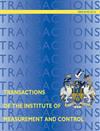Distributed nonsingular terminal sliding mode control–based RBFNN for heterogeneous vehicular platoons with input saturation
IF 1.9
4区 计算机科学
Q3 AUTOMATION & CONTROL SYSTEMS
Transactions of the Institute of Measurement and Control
Pub Date : 2024-01-06
DOI:10.1177/01423312231197848
引用次数: 0
Abstract
In this paper, a distributed nonsingular terminal sliding mode control (NTSMC) is proposed for vehicular platoons subjected to nonlinear uncertainty, external disturbance, and input saturation. Due to the presence of input saturation, the platoon control becomes more complicated. However, only considering the impact of uncertainty on the system, input saturation will usually lead to a decline in the driving performance, even lead to string instability. First, the input saturation is compensated by a single parameter, which is simple and direct. The radial basis function neural network (RBFNN) based on disturbance observer is employed to compensate the nonlinear uncertainty and external disturbance, respectively. The basis function of neural network is only related to the velocity and acceleration of the leader. Therefore, the nonlinearity of the vehicle systems does not need to meet the matching conditions. Then, a distributed NTSMC is designed to realize the internal stability, which weakens the chattering of traditional sliding mode control (SMC) to some extent. In addition, the nonsingular problem in terminal sliding mode control (TSMC) is solved. The string stability is realized by employing a coupled sliding mode control (CSMC). Finally, simulation results demonstrate the effectiveness and feasibility of the proposed strategy.基于 RBFNN 的分布式非奇异终端滑动模式控制,用于具有输入饱和度的异构车辆排群
本文提出了一种分布式非奇异终端滑模控制(NTSMC),适用于受非线性不确定性、外部干扰和输入饱和影响的车辆排。由于输入饱和的存在,排控制变得更加复杂。然而,仅考虑不确定性对系统的影响,输入饱和通常会导致驾驶性能下降,甚至导致车串不稳定。首先,通过单一参数补偿输入饱和,简单直接。采用基于扰动观测器的径向基函数神经网络(RBFNN)分别对非线性不确定性和外部扰动进行补偿。神经网络的基函数只与领航员的速度和加速度有关。因此,车辆系统的非线性无需满足匹配条件。然后,设计分布式 NTSMC 来实现内部稳定性,这在一定程度上削弱了传统滑模控制(SMC)的颤振。此外,还解决了终端滑模控制(TSMC)中的非奇异问题。通过采用耦合滑模控制(CSMC)实现了串稳定性。最后,仿真结果证明了所提策略的有效性和可行性。
本文章由计算机程序翻译,如有差异,请以英文原文为准。
求助全文
约1分钟内获得全文
求助全文
来源期刊
CiteScore
4.10
自引率
16.70%
发文量
203
审稿时长
3.4 months
期刊介绍:
Transactions of the Institute of Measurement and Control is a fully peer-reviewed international journal. The journal covers all areas of applications in instrumentation and control. Its scope encompasses cutting-edge research and development, education and industrial applications.

 求助内容:
求助内容: 应助结果提醒方式:
应助结果提醒方式:


